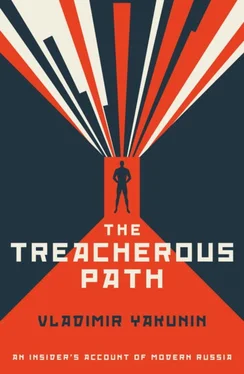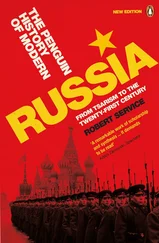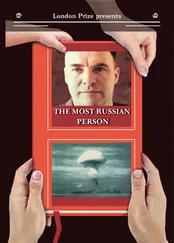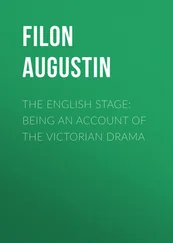But nobody seems interested in this kind of Russian story – a complex one of technocratic happenchance. Most people assume – perhaps it would be more accurate to say that people prefer to believe – a tale riddled with conspiracy: that I was part of the cabal of former KGB operatives infiltrated into the Russian government by a President determined to fight the cold war all over again; that at Ozero, the dacha cooperative in which I was once, long ago now, involved with Putin (he left the group many years ago), we plotted how we could divide the country’s riches among ourselves. That there is no truth in these suggestions, or what truth there is has been distorted and twisted beyond recognition, does not bother them; they only want to hear accounts that confirm the prejudices they already hold about Russia.
Ultimately, Putin was responsible for my relocation to the capital, but only indirectly. It was not because he parachuted the men with whom he had once shared a holiday home into responsible positions, but because of his interest in reforming every element of Russia’s bureaucratic system, which had the unplanned consequence of making my old role redundant, and ensured that I had to look for new opportunities.
Putin’s restructuring of the way that power flowed around the country was one of his most significant early actions. He was not only interested in the commands themselves, he was also engaged, in a way that his predecessors had not been, with the way in which those commands were being implemented and how answerable or not the people charged with implementing them were to him. He understood how to make sure that if he signed something it would be put into effect not just in the square mile outside the Kremlin, but in the very far reaches of the country too.
As I watched this transformation of the way in which Russia was administrated, from my tiny new office in the Transport Ministry, I was trying to get used to a very different kind of existence to that to which I had been previously accustomed. Anyone who has lived all their life in St Petersburg will know the strangeness of coming to the capital from the periphery. In Moscow, even people from big cities are seen as provincial. This feeling of disorientation was exacerbated, to begin with at least, by the challenges posed by getting to grips with an unfamiliar role.
At the time, Sergei Frank was one of the few ministers who thought strategically. He taught me that the state should have an integrated plan for development that included every element of the transport system, rather than treating railways and ports as separate spheres. It was also the strong belief of Sergei Frank that the Transport Ministry he headed should be a dynamic one – initiating projects instead of simply responding to events. Rather than working in a piecemeal fashion, his vision was that everything we did should be in accordance with a strategic plan that, once implemented, would harness the considerable latent potential of our transport infrastructure and put it at the service of the country’s economy.
One of the reasons why this potential remained latent, not realised, was that reform in this sector had hitherto been enacted in a notably inconsistent fashion. While the rail monopoly remained entirely in the state’s hands, the ports had been sold off – so, for instance, there was no coherent system for getting a load of coal from a rail wagon to a cargo ship. JSC Novorossiysk Commercial Sea Port, the largest port operator in Russia, was already a partially privatised company in which the state owned only a minority of the shares, and JSC Ust-Luga a PPP enterprise. Privatisation had led in many instances to greater competition and efficiency, but Russia’s economic resurgence depended on marrying these advances with a nationally implemented strategy and governmental oversight. The breaking apart of the monolithic Soviet transport system had created a fragmented situation in which the federal government, local authorities and private entrepreneurs rarely communicated, still less coordinated their operations. In the USSR, the same body had controlled both the airports and the planes that used them, but after 1991 the two operations were separated and left to fend for themselves in an environment without proper rules, regulations or legislation.
The transport system had become a fractured jumble of parts that moved independently of each other; what we were trying to do throughout the two years I spent at the Transport Ministry was to ensure as far as possible that they moved in concert. For example, we wanted to build, or modernise, ports that could each service the needs of a particular industry: Primorsk would carry oil, Ust-Luga would handle general cargo (including metals, coal, fertilisers, sulphur, machinery, ro-ro cargo, and a railway ferry), Vostochny would specialise in coal. Without a state-directed strategy, private enterprise would never even consider such an approach – why would they? Our role was to persuade them that not only would the country benefit if they were to get involved, but their businesses would thrive too.
You could compare us, I suppose, to an orchestra. No matter how talented the individual musicians are, no matter how beautiful the concert hall, if there is not a conductor they will only succeed in creating a discordant racket.
It was difficult, after having worked in the private sector and also the North-West Inspectorate, to find that, for all that some people continued to complain endlessly about government bureaucracy and red tape, at the heart of the system you actually had very little support. While there were several departments in the ministry who reported to me, I had no staff myself beyond a secretary and a single aide to help me do my job, and a suite of responsibilities that extended from the border with Finland to the Sea of Japan. And to begin with, I was unfamiliar with the relevant legislation, with the ministry’s processes or even the key personalities within the transport system. It was precisely because I knew that I had large gaps in my knowledge that I set out to learn as much as I could about the mechanisms by which different elements in the country’s transport infrastructure interacted, the importance of establishing connections between different industries, and, of course, the role that the Transport Ministry could play in all of this.
I had so much on my plate that I barely knew where to start, though my previous experience at Ust-Luga – where I had learned a great deal about port development and management as well as the way that they interacted with other elements within the transport system – gave me a good grounding in the area I was now working in. Many of the issues that I had encountered at Ust-Luga were reprised at the Transport Ministry – we were conscious of the absolute importance of reconciling public and private interests, but also the complexity and difficulty of doing so.
The other significant element was geo-political. Just as Ust-Luga was in part an attempt to redress the loss of the ports that had been assigned to the Baltic republics after the dissolution of the Soviet Union, so, for instance, at Novoship – the shipping company that operated out of Novorossiysk – we were trying to mitigate the consequences of the USSR’s collapse on the country’s cargo and passenger fleets. A large number of ships were given to Ukraine, with just a fragment remaining in our possession. If we wanted to rebuild the fleet to a standard that would make it competitive in the twenty-first century, then private investment was essential. Not least because foreign banks were unwilling to grant loans for ship construction and development to the Russian state (among other things, they were concerned about the stability of its banking system) and thus insisted that when Russian shipping companies wanted to place an order with foreign shipyards for a new ship, that a special new company should be created to be the owner of this ship and the bank’s client. [14] They would also have to fly the flag of another country – the Marshall Islands were always popular.
Читать дальше












